Caravanserais of Iran are of the most spectacular and important historical monuments in the country. Once upon a time, they served places of rest and refreshment for Caravans (Groups of Travelers) who could stop, eat and spend some time there in peace.
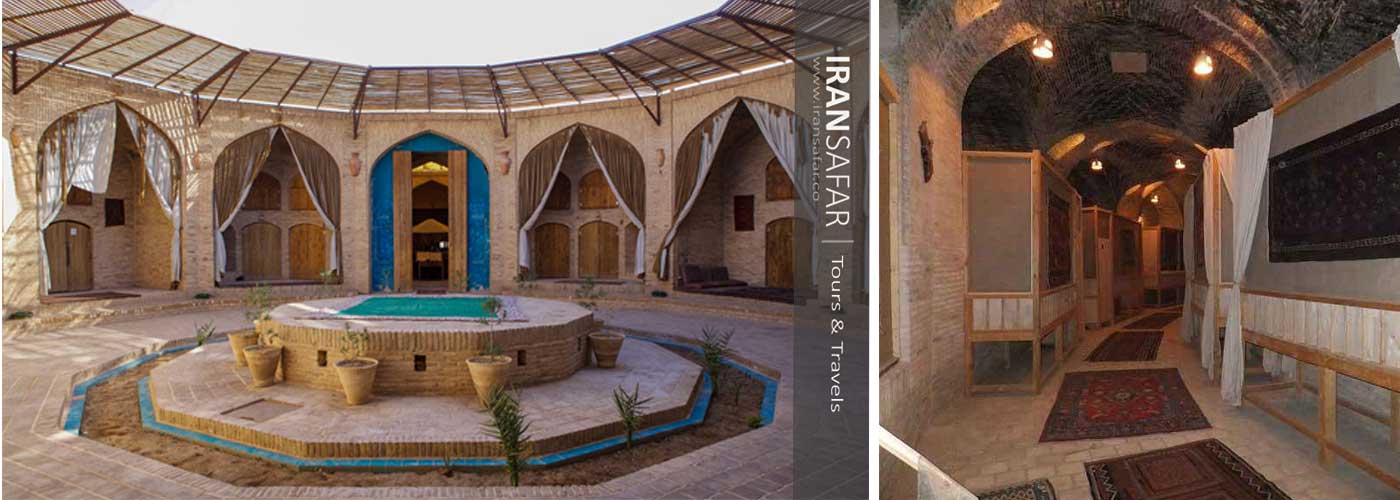 Zein-o Din Caravanserai, Mehriz ,Iran
Zein-o Din Caravanserai, Mehriz ,Iran
What is a Caravanserai?
As traffic along the Silk Road increased, so did the construction of caravanserais. They were needed as safe havens—not just from extreme climates and weather, but also from bandits who targeted caravans carrying silk, spices, and other valuable goods.
The layout of these structures also reflected their protective purpose. Often built just outside the nearest town or village, they were surrounded by immense walls resembling those of a fort with watch towers.
During 16th and 17th centuries, the busy roads of Iran were full of these caravanserais, each of which was built by a local ruler as a symbol of safety, security and comfort for Caravan Routes. They appeared roughly 32-40 Km (20–25 miles) apart—about a day’s journey—on the busiest Silk Road routes; A great achievement of old times!
Once very prosperous, these fascinating monuments have kept thousands of stories in their hearts and sometimes have become the treasury of their guests’ secrets.
Today, some of these old Caravansaries have been restored and converted into traditional hotels that you can stay in for your few day desert trips … and feel the peace of the desert with all your being!
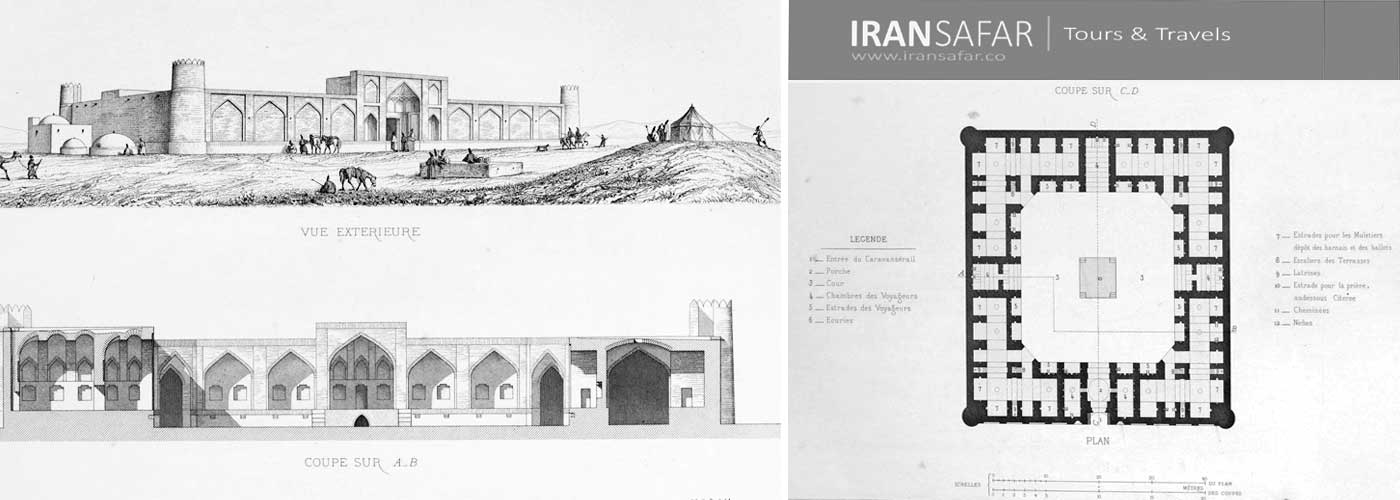 Pasangan Caravanserai plan by Pascal Coste
Pasangan Caravanserai plan by Pascal Coste
Caravansaries were established by religious foundations on pilgrim routes or by merchants’ guilds, as well as by local rulers or the kings on normal commercial routes, which were often identical with the pilgrim routes. In addition, especially in the reign of Shah Abbās the Great (r. 1588-1629), when the road system was highly extended throughout the country, the central government at Isfahan seems to have built many caravansaries along the new roads.
From the number of surviving caravanserais and from their appearance, it is clear that under Safavid Empire and Qajar eras there was a state architectural department that was specifically in charge for the construction of caravansaries and stations on the overland routes. Furthermore, in the cities a number of caravansaries were erected as lodging houses, depots, and commercial offices in the vicinity of the bazaars of Iran. They resembled the road caravansaries in form, except that most had two floors.
The Silk Road and Caravanserais
The Silk Road, often associated with the transmission of silk, was a complex network of trade routes connecting China, India, the Middle East, and the west. Caravanserais served as the backbone of this trade, enabling the movement of goods, culture, and ideas.
Caravanserais, also known as “Robat“, “Khan” or “Serai” in Persian, were strategically located along the Silk Road, which was a network of trade routes that connected the East and West. They were constructed during various dynasties in Iran, reflecting the evolving architectural styles and cultural influences of their time.
Most Famous Caravanserais in Iran
Iran boasts a variety of caravanserais, each with its own unique charm. From the iconic Zeinodin Caravanserai in Yazd to the picturesque Sa’ad al-Saltanah in Qazvin, these structures offer a glimpse into Iran’s rich heritage. While their original purpose has evolved, caravanserais remain an integral part of Iran’s cultural landscape. Many have been repurposed as museums, restaurants, or boutique hotels, giving tourists an opportunity to experience their history.
1
Caravanserai of Saad al-Saltanah
One of the most important caravanserais in Iran is the Saad al-Saltanah caravanserai located in the city of Qazvin, which stands out in this city with its unique beauty. Known as the largest roofed caravanserai in Iran, this ancient guest house dates back to the time of Nasser al-Din Shah Qajar (late 19th century) and is also known as “Sara-i Saadieh” and “Sarai Saadat“. This structure has been used commercially in the past as the largest commercial center of the city. The architecture of this caravanserai is so amazing and unique that you will be amazed to see it.
Sa’ad Al-Saltaneh Caravanserai consists of some labyrinth buildings and is surrounded by beautiful rooms with artistic decorations. Caravanserai has several entrances, 7 large courtyards, rooms, corridors and vestibules decorated with delicate brickwork. The most important part of the caravanserai is the Chaar-Souk section, on top of which there is a large dome with spectacular tile-works.
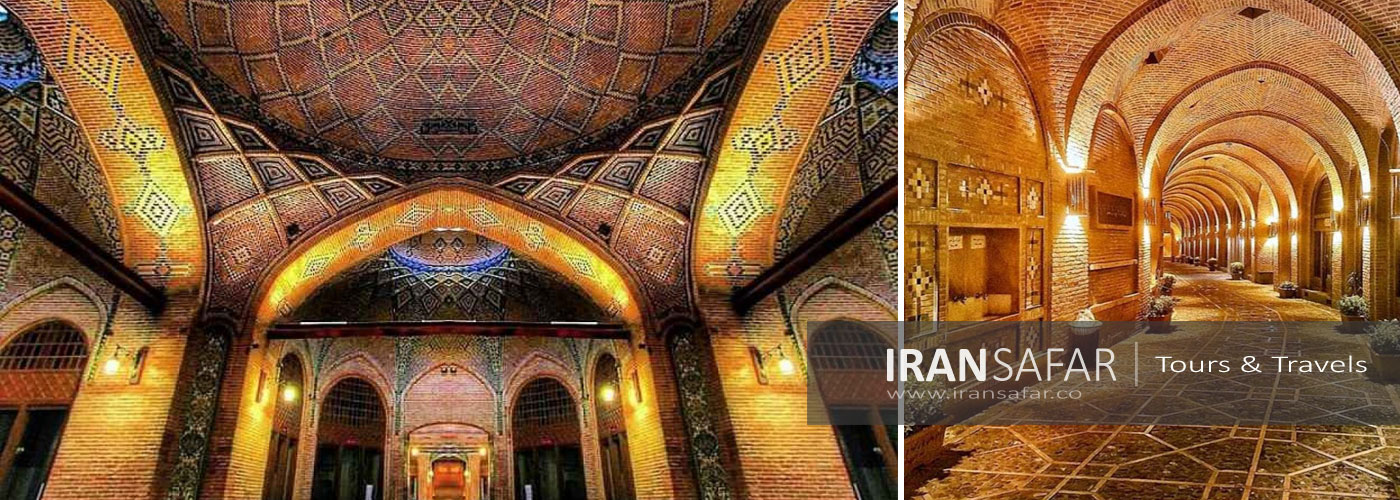 Caravanserai of Saad al-Saltanah, Qazvin, Iran
Caravanserai of Saad al-Saltanah, Qazvin, Iran
2
Qasr-e Bahram Caravanserai
Located near Garmsar town, 154 km south of Tehran, Caravanserai of Qasr-e Bahram was built during the Sassanid period (5th C) and rebuilt under King Abbas Safavid (16th C).
Qasr-e Bahram is notable for its architecture. When you look at this building from the outside, you will see a square building whose facade is covered with large white limestone. Unlike the most caravanserais in Iran, no brick or clay is used in constructing this monument. The two northern and southern gates allow entry and exit to the caravanserai and four tall and semicircular towers make its appearance more magnificent.
The gates lead the guests to a large octagonal courtyard that is surrounded by 24 rooms. An outstanding deep decorative pond in the middle of this courtyard completes its traditional appearance.
Qasr-e Bahram caravanserai is situated right in the middle of the vast protected area of Dasht-e Kavir with almost no inhabitants. This perfect peaceful location has recently become a perfect spot for Astronomers, astro-photographers as it is far from any light pollution.
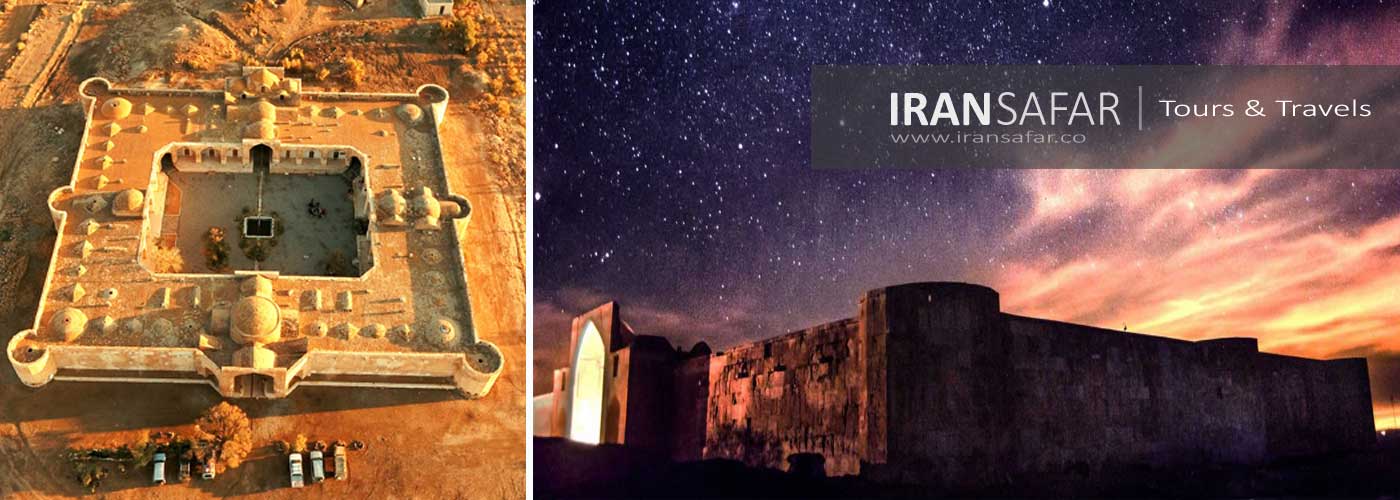 Caravanserai of Qasr-e Bahram, Garmsar, Iran
Caravanserai of Qasr-e Bahram, Garmsar, Iran
3
Zein-o-Din Caravanserai
During Safavid Era, when the construction of Caravanserais was common in Iran, the Zayn-o-Din (also Zein al-Din) caravanserai was built near the city of Mehriz. Located 60 km from Yazd to Kerman, 500 meters from the main road, the only circular caravanserai of Iran welcomes desert guests with the award for the best restoration of historical buildings. This caravanserai, which is a masterpiece of Safavid architecture, was built by the order of Zein-o-din, the ruler of Kerman in 17th century to provide facilities to travelers on the Silk Road which was, until 1500, the main trade route between Europe and Asia.
After its restoration, Zein-o-Din Caravanserai has operated as an inn.
The now 400 year old Zein-o-din structure is constructed from clay bricks covered with Kaah-Gel; a combination of mud and Hey. The caravanserai is a two-storied structure with a 16-sided middle courtyard and a water pool. Unlike the usual method of building in Islamic Architecture, Zein-o-Din was designed circular. This Caravanserai is one of the most beautiful buildings of Safavid era and from architectural material point of view is not comparable to any other structure of the same kind. Reason for choosing a round and circular shape for the Zein-o-Din caravanserai was the ability to withstand sand storms in the central desert and to moderate the temperature inside. However, some experts have cited a third reason for the structure’s round shape and believe that this type of construction was chosen to further protect the place against looting and bandit attack.
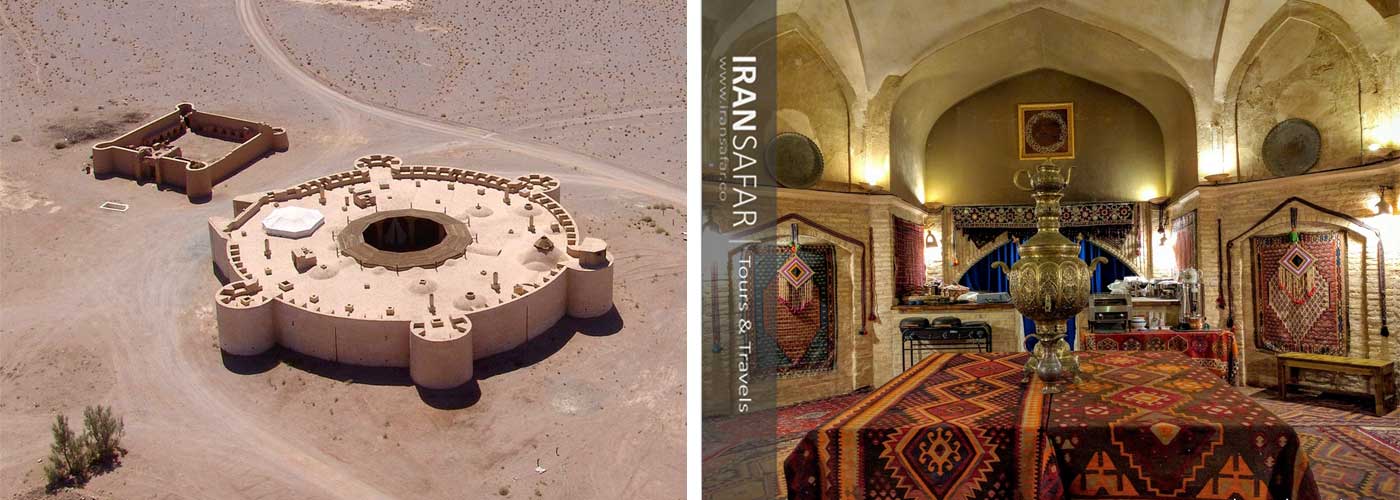
The Zein-o-Din Caravanseri is now used as a hotel with the slightest changes to the building. Passing through the wooden gate, to the left and right, there are original dormitory corridors with wooden platforms covered with thick cloths for privacy. At the bottom of the porches there are also private rooms for sleeping visitors, which used to be storage space for valuable luggage of travelers in the past. Iranian rugs are spread on the floor of each room and there is no sign of bed … mattresses and blankets will take you back in time!
4
Ti Ti Caravanserai
Lady Ti Ti, Aunt of one of the Safavid kings (17th century) decided to build a beautiful caravanserai in her name in Siaah-kal city located in north Iran. At 10 km of Siaahkal – Deylaman road, on the slopes of a high and green hill which used to be on the caravan route from Lahijan to Deylaman and Taleghan caravans, within Alborz mountain range, you will find the astonishing Ti Ti caravanserai built with stone and bricks. The complex consists of a central courtyard, a porch passage and two short Evans. This place is registered as an Iranian National Heritage.
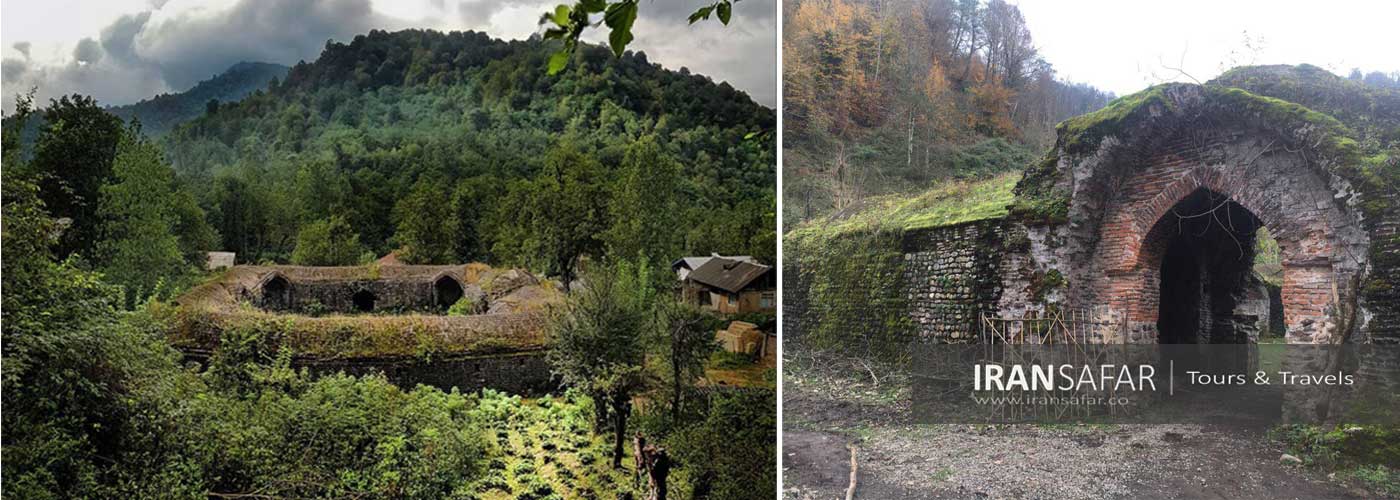
5
Robat Sharaf Caravanserai
Located 45 km from Sarakhs city, the historical caravanserai of Robat Sharaf, which dates back to 1144 AD is worth a visit. This caravanserai consists of two inter-related four Iwan planned courtyards, famous for owning some of the most diverse and beautiful brick decorations in Iranian architecture. With a facade of plaster and brick, Robat Sharaf has exhibited one of the architectural masterpieces of Iran. When you look at this caravanserai from a distance, it looks as if a large castle is located in front of you, but by going inside it, a magnificent palace becomes visible to you. Islamic architecture and strict observance of all the principles of Iranian architecture in the construction of this caravanserai has made it a palace-like mansion.
In Persian language (Farsi) the Arabic term rebāṭ, means a fortified resting place on a land route. This term was common until 16th century and then was replaced by Caravanserai or Robat.
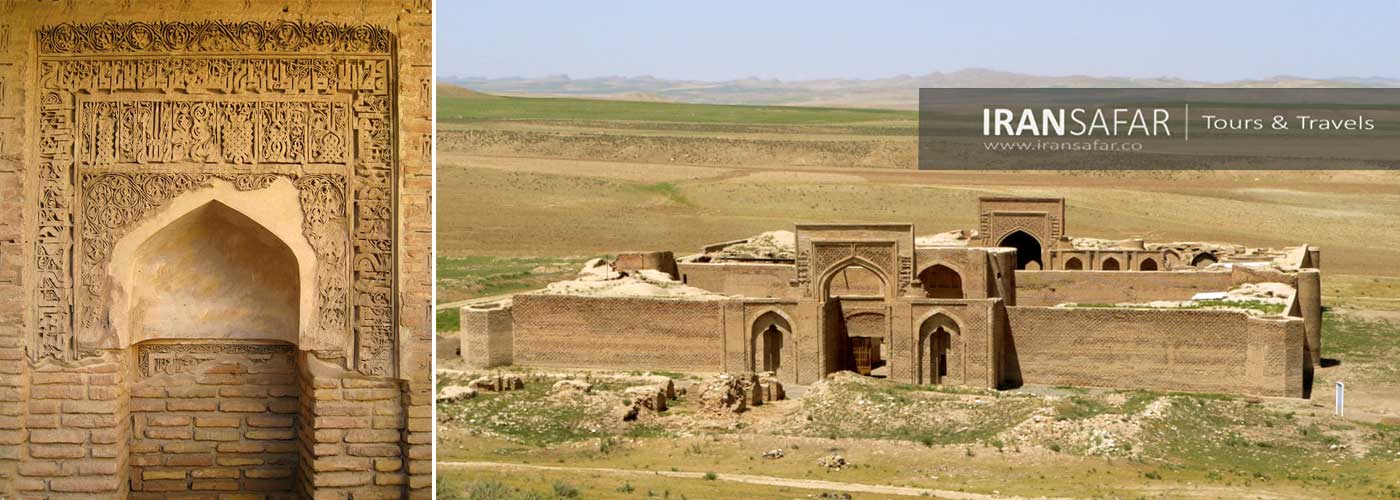
6
Shah’s Mother Caravanserai
Among the architectural works left from the Safavid era in Isfahan, a remarkable complex has survived which includes a school, a small bazaar and a caravanserai that shines like a unique gem next to Chaharbagh Street in Isfahan.
Today known as Abbasi hotel of Isfahan, this complex was constructed as a royal caravanserai about 300 years ago, and with restoration project of 1959 it converted into a luxury hotel. This complex was built by the order of Shah Sultan Hussein Safavid (r.1694-1722) and he gifted this complex to his mother and for this reason in ancient times this place was known as the inn of the king’s mother. Soon, this caravanserai became an important place for trade in Isfahan, but at the end of the Safavid rule, with the Afghan invasion of Isfahan, serious damage was imposed to this complex.
Today, Abbasi hotel is a treasury of the architectural art and unique subtlety of the Isfahani artists, a museum of the most original and most beautiful pieces of art. Abbasi offers a charming environment alongside many helpful amenities designed to enhance the quality of your stay.
7
Maranjab Caravanserai
Maranjab caravanserai is one of the caravanserais built during Shah Abbas Safavid who ordered to build hundreds of caravanserais on the main and busy caravan routes between cities. Maranjab Caravanserai is about 350 years old and its name has been registered in the list of national monuments of Iran. It was constructed on the way from Isfahan to the holy city of Mashhad.
Currently, Maranjab Caravanserai has regained its use and continues to work as a guest house. This caravanserai has been welcoming guests since 10 years ago, and its rooms are comfortable.
8
Meybod Caravanserai
One of the most prominent legacies of the Safavid era throughout Iran is the numerous and significant caravanserais. One of the finest examples of these can be found in Meybod, Yazd. Due to its ancient history and remarkable architecture, it has earned a place on Iran’s list of national monuments.
During its zenith, Meybod played a pivotal role as a bustling trading center along the Silk Road. To accommodate the needs of merchants and travelers, the city boasted a network of caravanserais. These timeless relics, known for their intricate architectural designs, have borne witness to countless tales of trade, culture, and exchange, thus forming an integral part of Meybod’s rich heritage.
Read : Meybod – Unveiling the Hidden Gems of Iran’s Historic Town
Caravanserai’s Architecture
Caravanserais stand as a testament to the triumphs of Persian architecture. They were designed with both form and function in mind. They typically had high walls for security, guardtowers for defense, a central courtyard for gatherings, dormitaries and rooms for accommodation. The intricate tile work, arches, and inscriptions showcased the artistic prowess of their builders.
These structures were often quite large and intricately designed. For instance, a famous Seljuk caravanserai in Sabzavar featured 1,700 chambers. They exemplify a remarkable harmony between function and structure. The fundamental design of later caravanserais remained consistent, featuring concentric layouts with blank outer walls, allowing access only through a single easily defensible portal. The central courtyard was typically surrounded by open arcades, akin to a mosque or madrassa.”
Also Read – Architectural Features in Ancient Persia
Caravanserias of Iran – FAQs
Q. What is the purpose of a caravanserai?
Caravanserais served as rest stops for traders, offering accommodation, safety, and trade opportunities along trade routes.
Q. How many caravanserais are there in Iran?
Iran is home to hundreds of caravanserais, each with its unique history and architectural features.
Q. Are caravanserais still in use today?
While their original purpose has evolved, many caravanserais have been repurposed for tourism, serving as museums, hotels, and restaurants.
Q. What is the significance of the Silk Road in relation to caravanserais?
The Silk Road was a vast trade network that relied heavily on caravanserais to facilitate trade and cultural exchange.
Q. How can I visit caravanserais in Iran?
Many caravanserais are open to tourists, offering a unique opportunity to explore these historic sites.

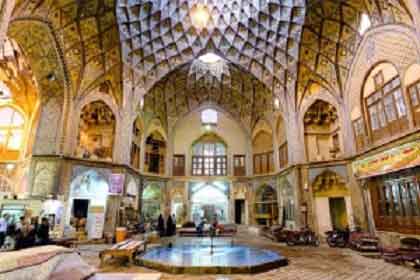

Comment (0)